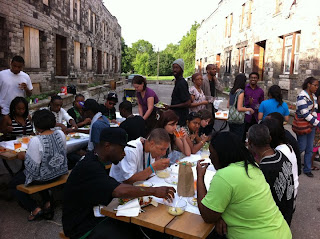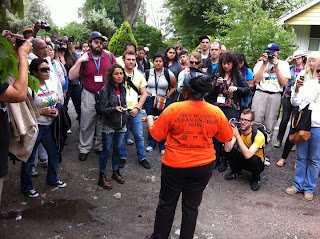By Adrienne M. Brown
 |
| Octavia Butler |
At the 2011 Allied Media Conference there was an entire track on Science Fiction and Movement which had a lot of relevant content for an organization like the East Michigan Environmental Action Council. I want to share the planning notes of the Octavia Butler and Emergent Strategy session, which is in some ways inspired by the deep work EMEAC does. Enjoy!
Opening Thoughts:
The most successful strategies in black science fiction writer/prophet Octavia Butler’s books are emergent strategies – meaning the characters are themselves shifting conditions, or caught in shifting conditions, that allow new possibilities for their evolutionary work. Within that shifting work, they are emerging new strategies.
"Strategy is a word of military origin, referring to a plan of action designed to achieve a particular goal. Strategy is a comprehensive way to try to pursue political ends, including the threat or actual use of force, in a dialectic of wills – there have to be at least two sides to a conflict. These sides interact, and thus a Strategy will rarely be successful if it shows no adaptability.” - Wikipedia
In the organizing/non-profit world we currently live in, we are constantly encouraged to define strategy in the terms of the status quo.
As an organizational healer, I often see folks who want to make a change or impact on the world fall short the moment they try to become strategic. Though they might be trying to create a new world within the main space of their organizing, more often, I see groups fall into the familiar, functioning in a way that is counter to the values they espouse.
To begin anew in terms of organizational development and strategic planning, i think we need to first come up with our own definition for strategy: Think of the strategic plans, the strategies you see in the movement work…how would WE (who are seen as not strategic BECAUSE we are emergent) define strategic?
One key seems to be the ability to engage in emergent strategies.
Emergent Strategies in Octavia Butler:
"Emergence is the way complex systems and patterns arise out of a multiplicity of relatively simple interactions." - Dictionary.com
Instead of all of our work being focused on an end goal, a win, we need to see our strategy as a constantly emerging process where we apply lessons and advance our values and principles in our actions. For me, Butler's work gives us several examples of this type of strategy in practice.
In the Parables Series, the main character (Lauren) has to devise a new strategy after her post-apocalyptic intentional community is decimated by the futuristic radical right wing. Lauren is holding a spiritual vision, not just a political one. She ends up going door to door to share her vision, her philosophies. I think about this story a lot when I hear organizations tending towards institution building. Do you understand the philosophy you are trying to advance, and are you flexible enough to focus on the philosophy instead of the structure. In this instance, the emergent strategies are relationship building; taking whoever comes - seeing each person, regardless of class, race, ability, gender, sexuality, as a potential revolutionary; focusing on being philosophically/spiritually rooted as opposed to institution building.
I think the Xenogenesis series is the ultimate emergence book. Lead character Lilith wakes up all alone in an alien world, and becomes a leader in the process of evolving humanity by integrating with another species. As she goes through the process of figuring out her survival, it becomes more and more clear that the alien Oankali have power and they are the ones integrating her, and other humans, into their existence. Lilith has an immense capacity for grief and loss, and being alone (having already lost her family on earth). The strategies in this collection are Lilith's emergent learning and adaptation based on survival instinct - having survived makes you the strongest possible next leader.
This reminds me of one of the principles of Allied Media Projects, EMEAC's partner in Detroit Future Media: “The most effective strategies for us are the ones that work in situations of scarce resources and intersecting systems of oppression because those solutions tend to be the most holistic and sustainable.”
Perhaps most relevant to us is the strategy that brings the downfall of the evil body snatcher Doro in the Patternist series. His daughter Mary is able to conquer him by working with the full interconnected network of telepaths who have developed the capacity to flow all of their individual smaller energies together to bring down one massive oppressive and deadly opponent. Doro underestimates them because he cannot even understand what they are doing. The emergent strategy here is collective organizing with trust – Doro lost because he couldn’t be a part of the collective or the whole. The other strategy was clear understanding of the necessary roles – understanding the nodes who could connect the network, and who had enough energy to be drawn upon.
In the Patternist series, the revolution/counter-revolution is very present: within two books the liberated network of telepaths have evolved into the oppressive patternmasters – oppressing humans, who they call ‘mutes’ and battling a new human hybrid species created by an alien disease. The new species becomes the revolutionary force in the wild, an organic force that primarily exists in their bodies, not their minds.
So if we think of emergent strategy as intentional, strong because it is decentralized, adaptive, interdependent, and creating more possibility, rather than coming to a victorious end, it changes the way we approach our organizing.
Discussion:
The participants had several rounds of conversation to explore these ideas, around prompts such as:
- what would change if we applied these strategies to our current organizing?
- what would be the indicators of excellent emergent work in organizing?
- how would we evaluate emergent leaders?
- in a world where we focus on emergence, how do plans serve us?
We openly discussed how shifting away from long-term inflexible plans, and into long-term strategic intentions & aligned principles where we determine our next moves by reflecting.
Each participant was then asked to make a commitment to shifting into emergent strategy in their own work and life.
EMEAC is already doing this kind of thinking or and organizing. We invite you to join us.
















